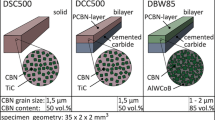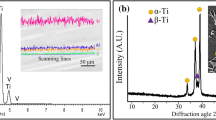Abstract
To completely understand wear mechanisms of mixed ceramic cutting tools (Al2O3–TiC), residual stress states and the superposition of external loads during hard turning should be investigated. This can be done via X-ray diffraction using high-energy synchrotron radiation to determine lattice strains in the material. For this reason, in first model tests, strain states in mixed ceramics were determined during the application of external loads. An experimental setup was developed to measure lattice strains in the different phases of the ceramic material in situ during thermal, mechanical and thermo-mechanical loading for first reference. The accuracy of the setup was sufficient to clearly determine shifts in lattice parameters in the different phases due to external loads. By applying a thermal load on the mixed ceramic material the two main phases showed different elastic lattice strains. Thus, a slightly lower coefficient of thermal expansion in the Al2O3-phase than in the Ti(O,C)-phase could be determined. This indicated the development of compressive stresses in the Al2O3-phase and tensile stresses in the Ti(O,C)-phase at room temperature. By applying external bending stresses to the mixed ceramic material, for both phases equal lattice strains could be determined. From these strains stresses could be calculated for both phases which were in the same order of magnitude as external stresses. With further in situ investigations of strain and stress states in the different phases of mixed ceramics during friction and turning experiments a more comprehensive characterization of wear mechanisms is possible.







Similar content being viewed by others
Notes
Optics consisted of two flat water-cooled Laue crystals Si(111) and Si(220) 15 × 30 × 1.5 mm in dimensions, with an asymmetric angle of 35.36°. For an incoming energy of 87 keV, the Si(220) crystal was placed into the white synchrotron radiation beam.
References
Uhlmann E, Richarz S, Fuentes JAO (2011) Hartdrehen von PM-Schnellarbeitsstahl. Diam Bus 1:10–19
Ophey L (1998) Trockenbearbeitung. Bearbeitung metallischer Werkstoffe ohne Kühlschmierstoffe. Expert, Renningen-Malmsheim
Kumar AS, Durai AR, Sornakumar T (2006) Wear behaviour of alumina based ceramic cutting tools on machining steels. Tribol Int 39:191–197
Bhattacharya AK, Zimmermann K, Schneider GA, Hintze W (2008) Influence of surface modification on the cutting performance of reaction-sintered Al2O3–TiOC ceramics. J Am Ceram Soc 91:2982–2986
Cakan A (2011) Real-time monitoring of flank wear behavior of ceramic cutting tool in turning hardened steels. Int J Adv Manuf Tech 52:897–903
Dureja JS, Gupta VK, Sharma VS, Dogra M (2010) Wear mechanisms of coated mixed-ceramic tools during finish hard turning of hot die steel. J Mech Eng Sci 224:183–193
Singh D, Rao PV (2010) Flank wear prediction of ceramic tools in hard turning. Int J Adv Manuf Techol 50:479–493
Pfeiffer W, Frey T (2006) Strengthening of ceramics by shot peening. J Eur Ceram Soc 26:2639–2645
Vogli E, Tillmann W, Selvadurai-Lassl U, Fischer G, Herper J (2011) Influence of Ti/TiAlN-multilayer designs on their residual stresses and mechanical properties. Appl Surf Sci 257:8550–8557
Jianxin D, Zhenxing D, Dongling Y, Hui Z, Xing A, Jun Z (2010) Fabrication performance of Al2O3/(W, Ti)C + Al2O3/TiC multilayered ceramic cutting tools. Mater Sci Eng, A 527:1039–1047
Deng JX, Yun DL, Zhou HM, Tan YQ (2012) Layered structures in ceramic nozzles for improved erosion wear resistance in industrial coal-water-slurry boilers. Ceram Int 36:299–306
Hussainova I, Kolesnikova A, Hussainov M, Romanov A (2009) Effect of thermo-elastic residual stresses on erosive performance of cermets with core–rim structured ceramic grains. Wear 267:177–185
Bartolomé JF, Aza AH, Martín A, Pastor JY, Llorca J, Torrecillas R, Bruno G (2007) Alumina/zirconia micro/nanocomposites: a new material for biomedical applications with superior sliding wear resistance. J Am Ceram Soc 90:3177–3184
Gibmeier J, Hartmann S, Scholtes B (2005) Effect of applied and residual stresses on the analysis of mechanical properties by means of instrumented indentation techniques. Mater Sci Forum 490–491:454–459
Waikar RA, Guo YB (2007) Residual stress evolution and mechanical state of hard machined components in sliding contact. Tribol Trans 50:531–539
Kurt A (2009) Modelling of the cutting tool stresses in machining of Inconel 718 using artificial neural networks. Expert Syst Appl 36:9645–9657
Fitzpatrick ME, Hutchings MT, Withers PJ (1997) Separation of macroscopic, elastic mismatch and thermal expansion misfit stresses in metal matrix composite quenched plates from neutron diffraction measurements. Acta Mater 45:4867–4876
DIN EN 843-1 (2008) Hochleistungskeramik—Mechanische Eigenschaften monolithischer Keramik bei Raumtemperatur—Teil 1: Bestimmung der Biegefestigkeit. Beuth, Berlin
Zimmermann K, Schneider GA, Bhattacharya AK, Hintze W (2007) Surface modification of Al2O3/TiC cutting ceramics. J Am Ceram Soc 90:3773–3778
He BB (2009) Two-dimensional X-ray diffraction. Wiley, Hoboken
Wojdyr M (2010) Fityk: a general-purpose peak fitting program. J Appl Cryst 43:1126–1128
Rohrbach C, Ahrensdorf K (1989) Handbuch für experimentelle Spannungsanalyse. VDI, Düsseldorf
Salmang H, Scholze H (2007) Keramik. Springer, Berlin
Eigenmann B (1992) Röntgenographische Analyse inhomogener Spannungszustände in Keramiken, Keramik-Metall-Fügeverbindungen und dünnen Schichten. Dissertation Karlsruhe University
Schnell W, Gross D, Hauger W (1998) Technische Mechanik. Springer, Berlin
Acknowledgments
The authors gratefully acknowledge Gühring oHG for financial support.
Author information
Authors and Affiliations
Corresponding author
Rights and permissions
About this article
Cite this article
Eichenseer, C., Wittmann, I., Hartig, C. et al. In situ measurement of lattice strains in mixed ceramic cutting tools under thermal and mechanical loads using synchrotron radiation. Prod. Eng. Res. Devel. 7, 283–289 (2013). https://doi.org/10.1007/s11740-012-0426-2
Received:
Accepted:
Published:
Issue Date:
DOI: https://doi.org/10.1007/s11740-012-0426-2




